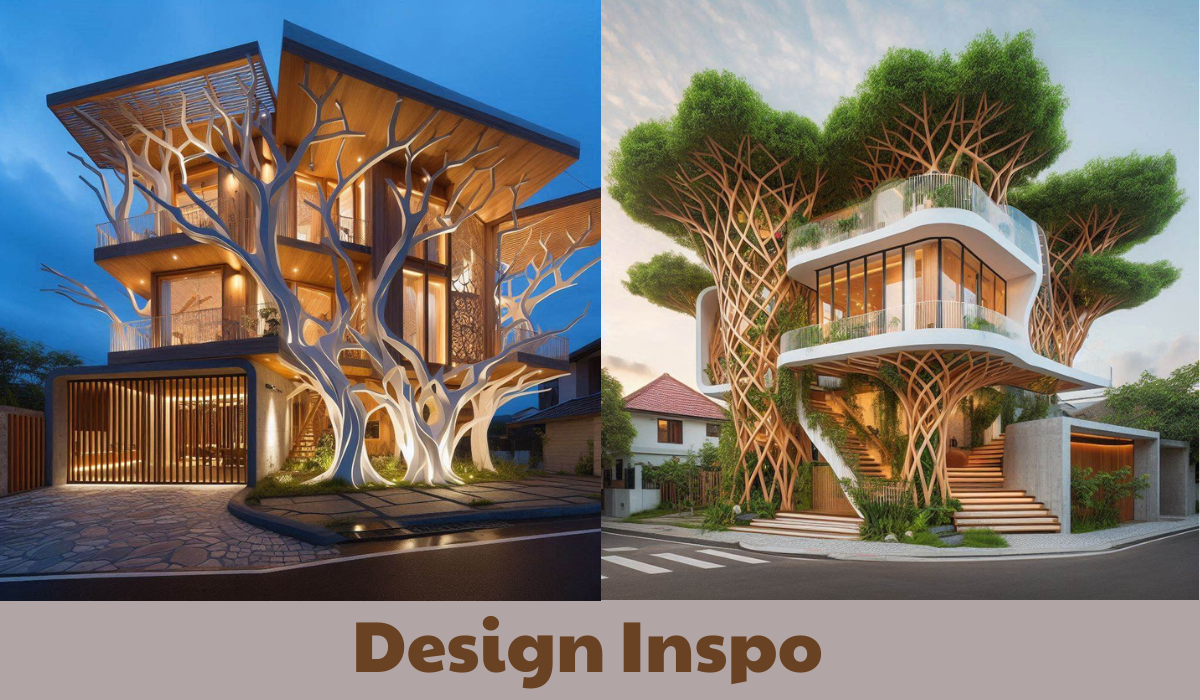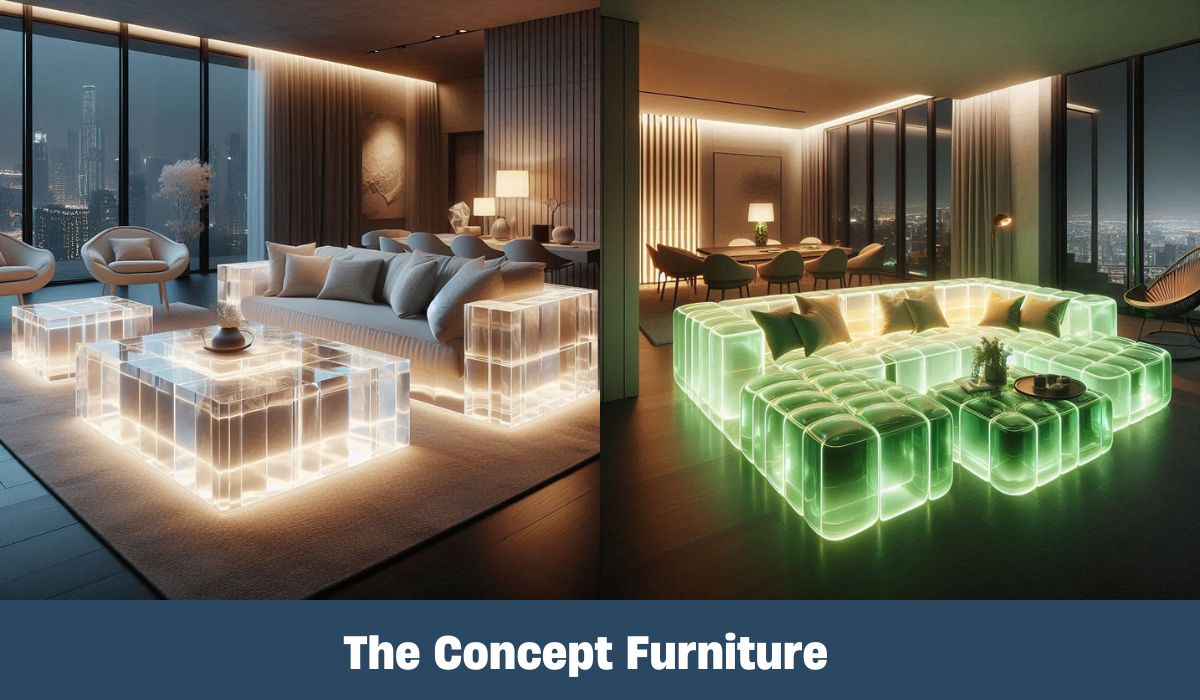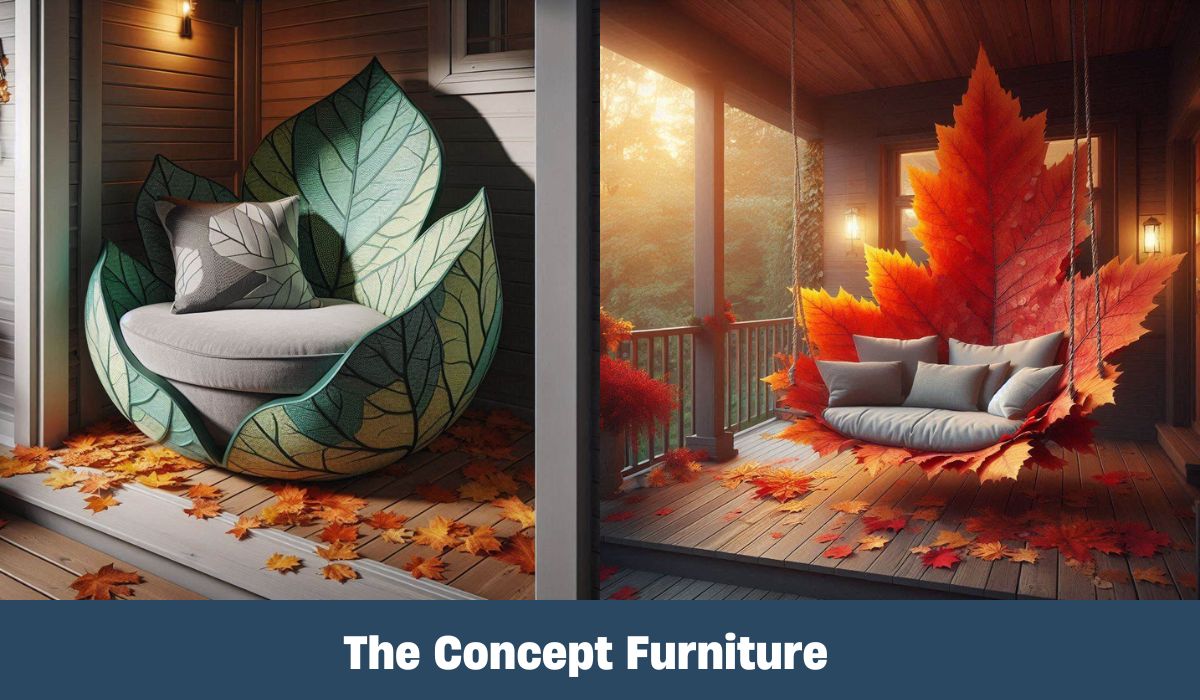Architecture inspired by nature’s trees offers a fresh perspective on design. Unlike traditional buildings that often ignore their surroundings, this approach embraces the beauty and functionality of nature. It blends organic shapes with modern materials, creating spaces that feel alive. The use of natural elements fosters harmony between structures and the environment. This connection enhances well-being and promotes sustainability.
Designs mimic tree canopies, creating inviting atmospheres that encourage community interaction. They elevate our urban spaces while reducing environmental impact. This innovative architecture not only looks stunning but also serves a purpose. It reminds us of the importance of nature in our lives. Discover how these designs transform our cities into greener, more vibrant places to live and work.
Understanding Architectural Biomimicry
Definition
Architectural biomimicry refers to designing buildings inspired by nature. This approach focuses on mimicking the forms, processes, and systems found in natural environments. It emphasizes organic shapes that blend with their surroundings.
Biomimicry is significant in modern design. It encourages architects to learn from nature’s solutions to complex problems. For example, trees adapt to their environment over time. They demonstrate how to optimize resources while maintaining structural integrity. Architecture Inspired by Nature’s Trees!
Nature’s Influence
Nature serves as a blueprint for innovative architecture. Trees, in particular, provide valuable insights into efficient design. Their branching structures allow them to maximize sunlight exposure. This principle can inspire designs that enhance natural light within homes.
The roots of trees illustrate stability and support. They anchor the tree firmly in the ground while absorbing nutrients. Similarly, architectural designs can incorporate strong foundations that promote sustainability.
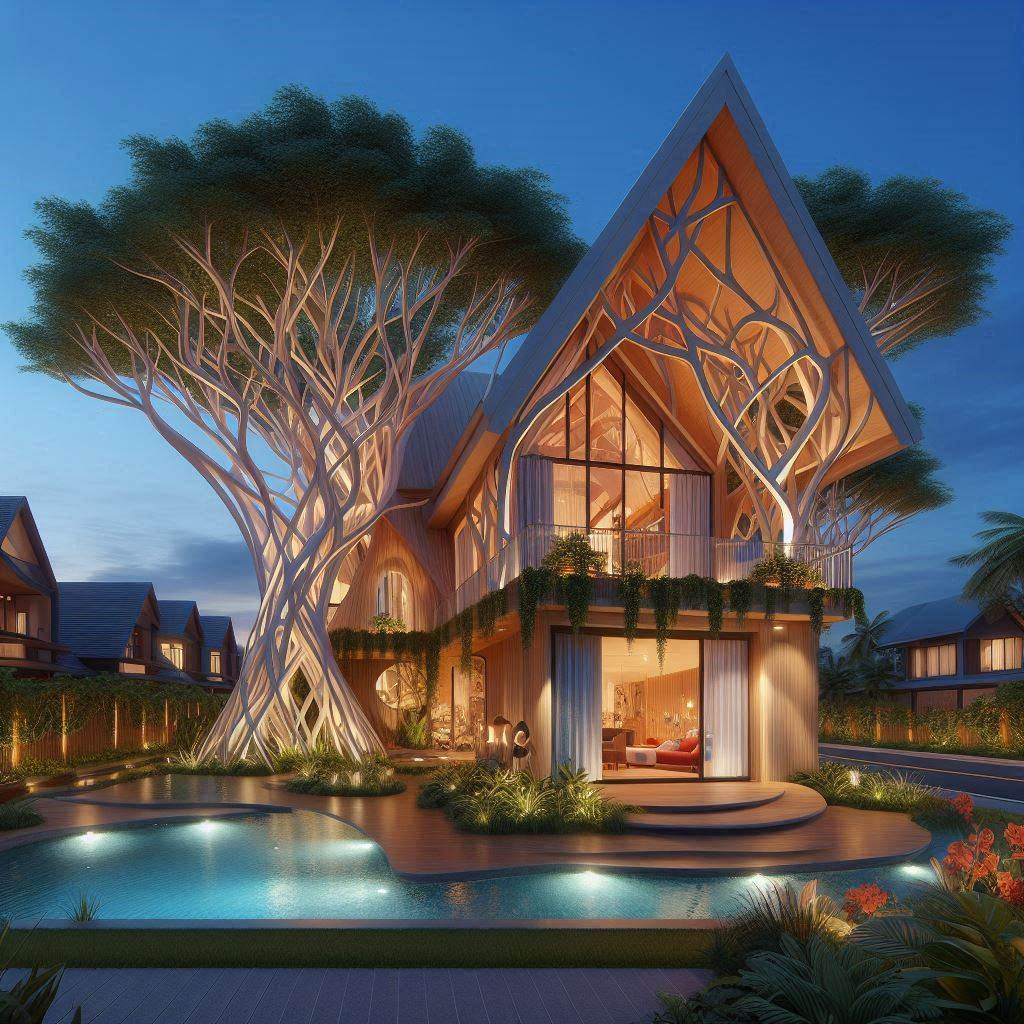
Sustainability Principles
Sustainability is a core principle derived from tree structures. Trees efficiently use resources like water and sunlight. They recycle nutrients through their leaves and bark. Architects can apply these concepts to create energy-efficient buildings.
Using materials that mimic tree bark can improve insulation. This reduces energy consumption for heating and cooling homes. Furthermore, incorporating green roofs can replicate a forest canopy. This promotes biodiversity and enhances air quality. Architecture Inspired by Nature’s Trees!
Designing with nature in mind leads to eco-friendly practices. For instance, rainwater harvesting systems can be modeled after how trees collect water. These systems help manage stormwater runoff effectively.
Efficiency in Design
Efficiency also plays a key role in architectural biomimicry. Trees adapt their growth patterns based on environmental conditions. This adaptability can inspire flexible building designs that respond to climate changes.
Incorporating organic shapes into architecture allows for better airflow and natural cooling. Buildings designed with curves can reduce wind resistance, leading to lower energy costs. Architecture Inspired by Nature’s Trees!
Architects can explore various materials inspired by tree structures. For example, lightweight composites can mimic the strength of wood without its weight. This innovation leads to sustainable construction methods.
Real-World Examples
Many modern buildings showcase architectural biomimicry inspired by trees. The Eden Project in the UK features geodesic domes that resemble plant structures. These domes create a controlled environment for diverse ecosystems.
Another example is the Bosco Verticale in Milan, Italy. These residential towers are covered with trees and plants, promoting urban greenery while providing insulation.
Emulating Tree Design in Green Houses
Structural Advantages
Tree-inspired designs offer unique structural benefits for greenhouses. The shape of trees provides natural stability. This design allows for better wind resistance, which is crucial for outdoor structures.
The curved forms of tree branches distribute weight evenly. This reduces stress on the greenhouse materials. Such designs can withstand harsh weather conditions. They also enhance durability over time. Architecture Inspired by Nature’s Trees!
Optimizing Light and Air
Tree shapes play a significant role in optimizing light and air circulation. The canopy of trees filters sunlight effectively. This mimics how light enters a greenhouse, providing an even distribution of light.
Plants need adequate light for photosynthesis. A well-designed greenhouse can maximize this by using angled surfaces. These surfaces direct sunlight to all areas of the greenhouse. Proper ventilation is also essential for plant health. Tree-inspired designs naturally promote airflow, reducing humidity levels.
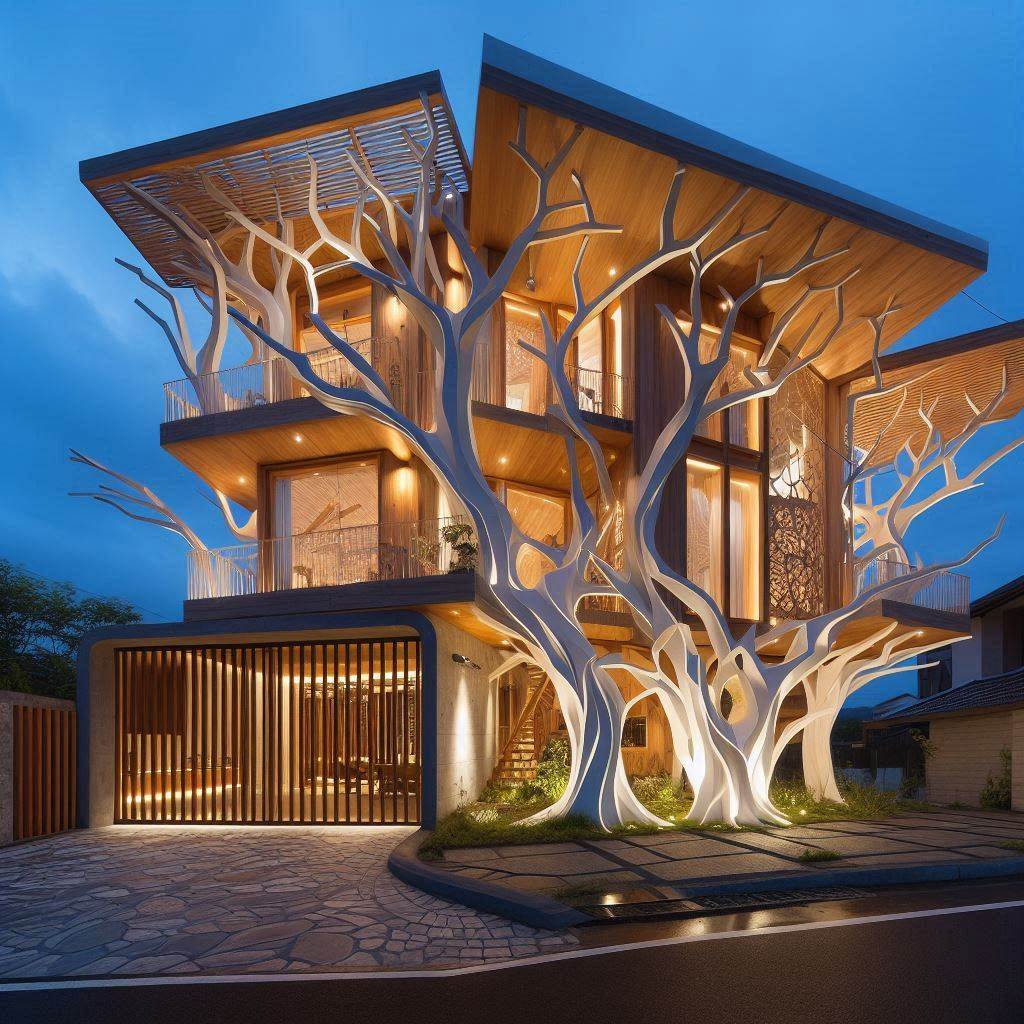
Materials for Resilience
Choosing the right materials is key to mimicking the resilience of trees. Many greenhouses now use polycarbonate panels that resemble tree bark. These panels are strong yet lightweight. They provide excellent insulation while allowing light to pass through. Architecture Inspired by Nature’s Trees!
Wood remains a popular choice due to its natural properties. It offers flexibility and strength, similar to tree trunks. Sustainable wood options also align with eco-friendly practices. Other materials like recycled metals can mimic the adaptability of trees in various environments.
Incorporating Decorative Greenery
Incorporating decorative greenery enhances the aesthetic appeal of greenhouses. Vertical gardens can be added to walls, resembling forest undergrowth. This not only beautifies the space but also improves air quality.
Plants that climb or hang can create a lush environment. They provide shade and reduce temperature fluctuations inside the greenhouse. This simulates a natural ecosystem where plants thrive together. Architecture Inspired by Nature’s Trees!
Green Designs for Sustainability
Green designs focus on sustainability and efficiency. They aim to reduce energy consumption while promoting plant growth. Integrating renewable energy sources into these designs can power heating and cooling systems.
Using rainwater collection systems further supports sustainability efforts. This mimics how trees absorb water from their environment, promoting conservation practices.
Stunning Examples of Tree-Inspired Architecture
Iconic Buildings
Architects have created stunning new build house designs that mimic trees. One example is the Treetop House in Sweden. Designed by architect Sasa Zivkovic, this structure features a wooden exterior that resembles tree bark. The design blends beautifully with its forest surroundings. Architecture Inspired by Nature’s Trees!
Another remarkable building is the Treehouse Hotel in Sweden. This hotel offers guests a unique experience among the branches. Each room has a view of the trees, creating a sense of peace and connection to nature.
Aesthetic Aspects
Tree-inspired architecture often combines beauty and functionality. Designers focus on organic shapes and materials. Curved lines mimic the natural forms of trees. This approach creates spaces that feel warm and inviting.
The use of natural light is another critical element. Large windows allow sunlight to filter through, just like leaves on a tree. This feature enhances the interior atmosphere, making it bright and airy. Architecture Inspired by Nature’s Trees!

Cultural Impact
Tree-inspired designs have gained popularity worldwide. They reflect a growing appreciation for nature in urban settings. People seek spaces that connect them to the environment.
Public reception has been positive. Many admire these buildings for their unique aesthetics. Others appreciate their eco-friendly features. These designs often use sustainable materials and energy-efficient systems.
Functional Aspects
Functionality plays a vital role in tree-inspired architecture. Buildings are designed not only to look good but also to serve practical purposes. For instance, many structures include green roofs that resemble canopies. These roofs help insulate buildings and manage rainwater. Architecture Inspired by Nature’s Trees!
e designs incorporate flexible spaces that adapt to different needs. Open floor plans allow for easy movement, similar to how trees provide shelter and space in nature.
Architectural Curiosities
Certain projects stand out as true architectural curiosities. The Bosco Verticale in Milan features vertical gardens resembling tree canopies. This high-rise building promotes biodiversity in an urban environment.
Another fascinating example is the Eden Project in the UK, with its geodesic domes inspired by tree forms. These structures house diverse plant species from various climates, showcasing the beauty of nature.
Million-Dollar Homes Inspired by Trees
Unique Designs
Luxury homes today often draw inspiration from nature, especially trees. These residences feature tree-like elements that blend beauty with functionality. For instance, the Tree House in New York City showcases a design that mimics branches and leaves. Its unique shape enhances natural light while providing stunning views of the urban landscape.
Another example is the Treetop House in Australia. This home features a wooden structure elevated above ground, resembling a treehouse. The use of natural materials creates a seamless connection between the home and its surroundings. These designs cater to those seeking tranquility in their everyday environs. Architecture Inspired by Nature’s Trees!
Key Features
Tree-inspired homes often include impressive landscaping. This aspect enhances the overall aesthetic and provides an inviting atmosphere. Many luxury residences incorporate green roofs or vertical gardens. These features not only beautify the property but also improve energy efficiency.
Large windows are common in these homes. They allow for ample sunlight and create a sense of openness. Some designs even integrate living walls, which bring nature indoors. This trend reflects a growing desire for sustainable living spaces.
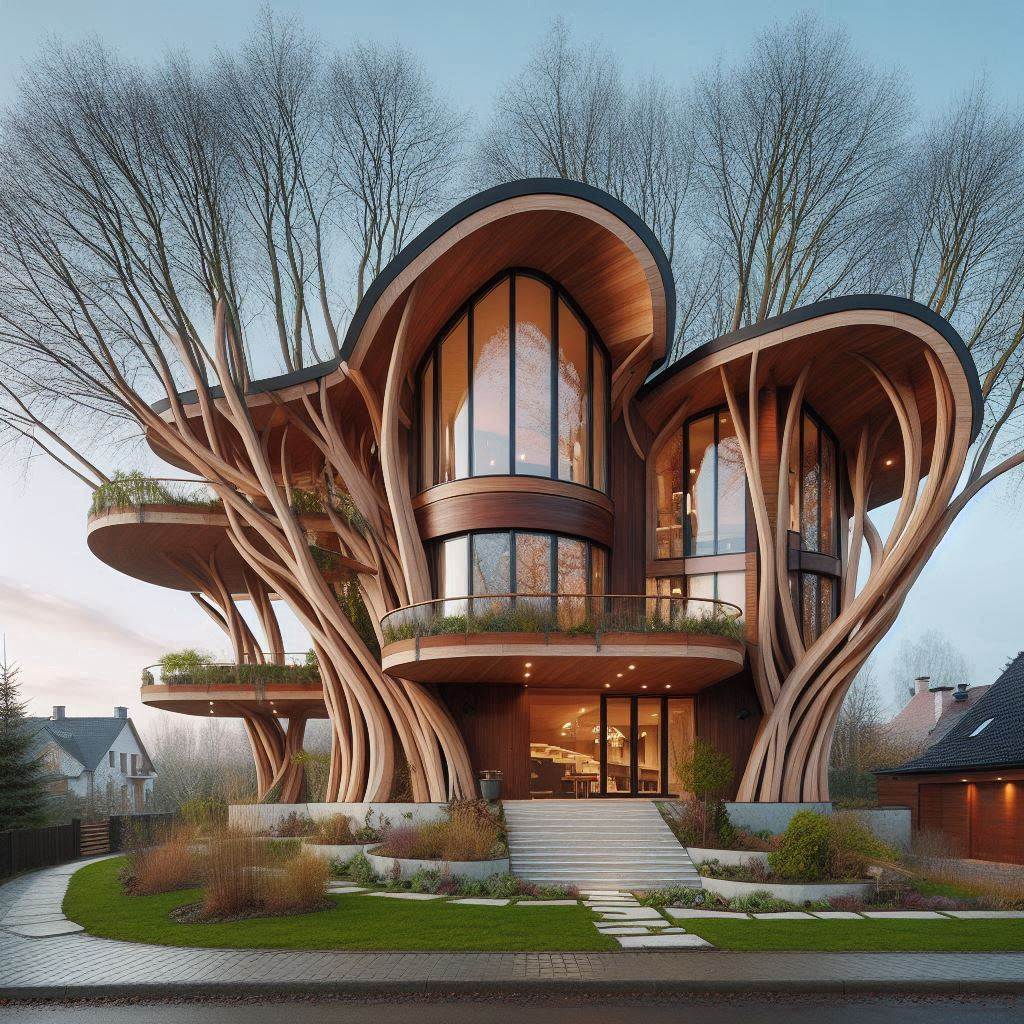
Market Trends
The demand for tree-inspired luxury homes has increased significantly in recent years. Buyers seek unique properties that stand out in the market. According to a report by the National Association of Home Builders, eco-friendly designs are among the top priorities for new homeowners.
Investors recognize this trend as well. They focus on properties with impeccable landscaping and innovative designs that promote harmony with nature. As urban areas expand, more people desire homes that offer an escape from city life. Architecture Inspired by Nature’s Trees!
Everyday Living
Living in such homes provides more than just aesthetic pleasure. It promotes well-being and relaxation. Nature has a calming effect on individuals, contributing to mental health improvement. Homeowners often report feeling more connected to their environment when surrounded by tree-inspired architecture.
These residences encourage outdoor activities too. Many have terraces or balconies filled with greenery, creating personal sanctuaries. Families can enjoy gatherings outside while being immersed in nature.
Public Buildings Reflecting Tree Designs
Community Spaces
Public architecture often uses tree motifs to create welcoming areas. These designs encourage people to gather and interact. They provide a sense of comfort and connection. Many modernist buildings incorporate these elements. This approach helps break down barriers between structures and the community.
Natural forms influence the layout of parks, libraries, and community centers. For instance, the tree-like canopies in public spaces offer shade and shelter. They invite people to sit and enjoy their surroundings. This design fosters social interaction among visitors. Architecture Inspired by Nature’s Trees!
Enhancing Interaction
The use of tree-inspired designs enhances community engagement. These buildings become more than just places; they transform into hubs of activity. People feel drawn to spaces that mimic nature. They are more likely to spend time in environments that reflect familiar elements like trees.
The incorporation of natural light is another key aspect. Large windows and open spaces allow sunlight to flood in. This design choice creates a warm atmosphere. It encourages collaboration and creativity among users.
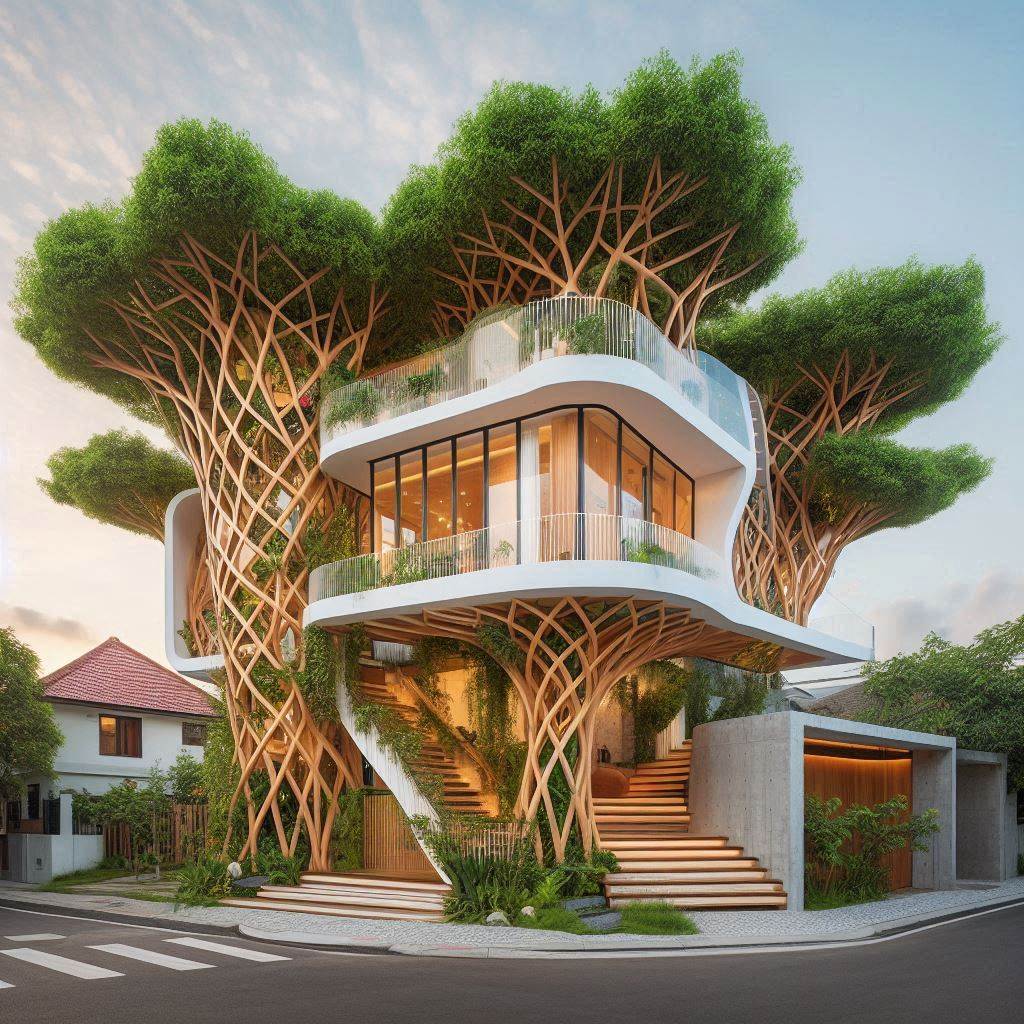
Notable Examples
Several public buildings successfully integrate tree-like features. The Kauffman Center for the Performing Arts in Kansas City stands out. Its roof resembles an open tree canopy, allowing light to filter through. This design connects the interior with the outdoors.
Another example is the Treetop Walkway in Germany. This structure features elevated pathways resembling tree branches. Visitors walk among the treetops, experiencing nature from a unique perspective.
The National Museum of African American History and Culture in Washington, D.C., also showcases this trend. Its exterior design draws inspiration from a baobab tree, symbolizing strength and resilience. The building invites exploration while honoring cultural heritage. Architecture Inspired by Nature’s Trees!
Architectural Innovation
Tree-inspired designs push the boundaries of conventional building systems. Architects blend aesthetics with functionality by mimicking nature’s forms. This innovation leads to unique residential design as well.
These modernist buildings often feature sustainable materials. They prioritize eco-friendliness while creating beautiful spaces. By integrating tree motifs, architects promote harmony between structure and environment.
In summary, public buildings that reflect tree designs create inviting spaces for communities. They enhance interaction and engagement through thoughtful architecture. The examples mentioned illustrate how these concepts come to life in various settings.
Integrating Architecture into Natural Landscapes
Blending Designs
Architects often seek ways to blend their designs with the natural environment. This approach enhances both aesthetics and functionality. Many architects use natural construction materials to harmonize buildings with their surroundings. For example, wood, stone, and clay can create a seamless transition between the structure and the landscape.
Landscape architects play a crucial role in this integration. They assess the terrain and existing vegetation before beginning any project. This assessment helps in planning structures that complement rather than disrupt the local ecosystem. Utilizing techniques like contour mapping can guide architects in designing buildings that follow the natural topography. Architecture Inspired by Nature’s Trees!
Preserving Ecosystems
Preserving local ecosystems is essential while designing new structures. Architects must consider the impact of their projects on wildlife and plant life. Implementing green roofs and walls can help support local flora and fauna. These features not only enhance biodiversity but also improve air quality.
Incorporating native plants into landscaping is another effective strategy. Native species require less water and maintenance, making them sustainable options. By prioritizing these plants, architects contribute to a healthier ecosystem while maintaining beautiful landscapes.
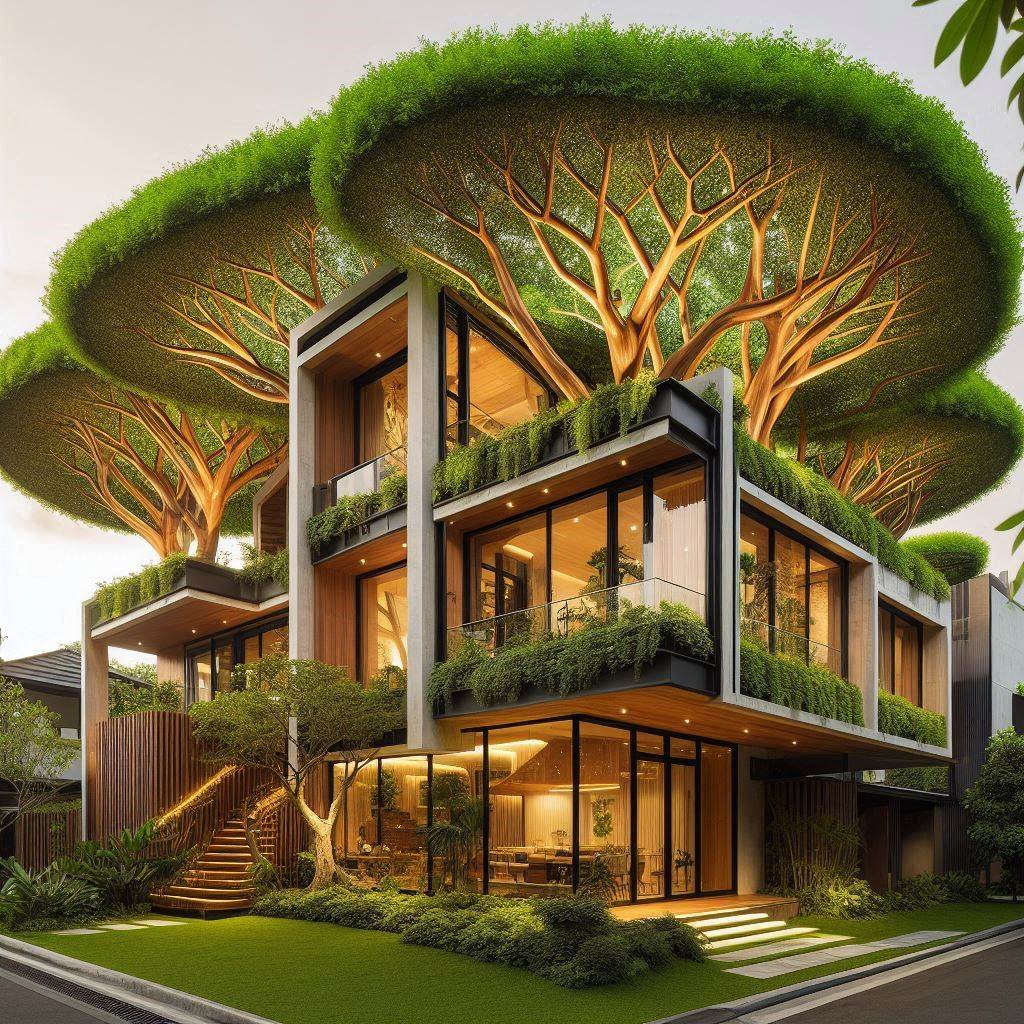
Minimizing Disruption
Minimizing visual and ecological disruption is vital for successful landscape integration. Architects can achieve this by using specific design techniques. For instance, they may employ earth-sheltering methods that reduce a building’s visibility from afar. Such designs allow structures to blend into the surrounding hills or forests.
Another technique involves strategic placement of windows and outdoor spaces. By orienting these features toward scenic views, architects can draw attention away from the building itself. This method allows for an appreciation of the landscape without overshadowing it. Architecture Inspired by Nature’s Trees!
The concept of a living building supports this idea further. Living buildings are designed to coexist with nature, minimizing energy consumption and waste production. They utilize renewable resources and aim for zero environmental impact. Many architects today strive to create such structures as part of their architectural style.
Environmental Benefits of Tree-Inspired Architecture
Energy Efficiency
Tree-inspired architecture significantly boosts energy efficiency. These designs often mimic the natural cooling properties of trees. For instance, structures can use shading techniques similar to tree canopies. This reduces reliance on air conditioning systems. Architecture Inspired by Nature’s Trees!
In 2016, a study showed that buildings designed with tree-like features could save up to 30% on energy costs. The incorporation of green roofs and walls also helps insulate buildings. This leads to lower heating and cooling demands, promoting resource conservation.
Biodiversity Promotion
Such architectural designs can enhance biodiversity. By integrating greenery into urban areas, these structures create habitats for various species. For example, vertical gardens can attract birds and insects. This interaction supports local ecosystems. Architecture Inspired by Nature’s Trees!
According to the World Wildlife Fund (WWF), urban areas with more vegetation tend to have higher biodiversity levels. Tree-inspired architecture encourages planting native species, which are essential for maintaining ecological balance. This approach aids in restoring habitats that have been lost due to urbanization.
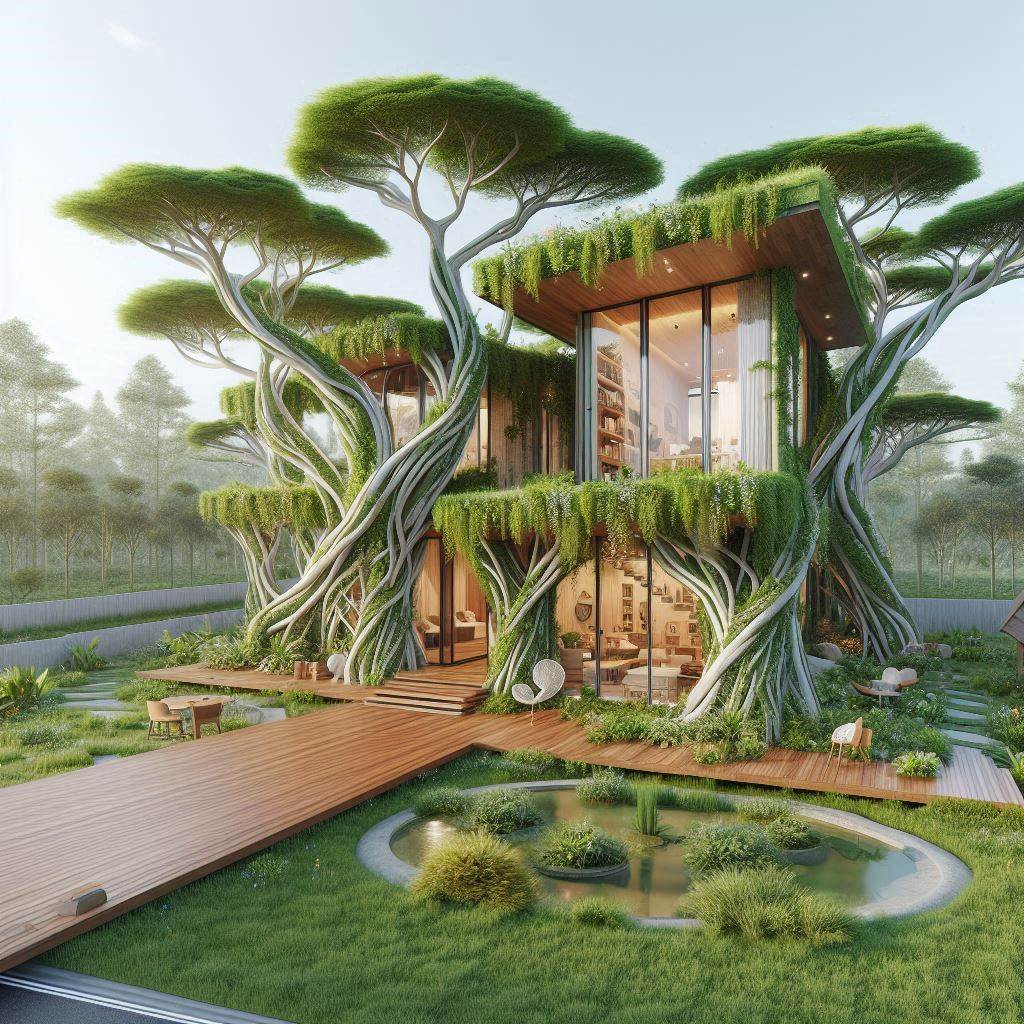
Urban Heat Reduction
Tree-like structures play a crucial role in reducing urban heat islands. These areas are significantly warmer than their rural surroundings due to human activities. Urban heat islands can lead to increased energy consumption and health issues.
In 2019, research indicated that cities could reduce temperatures by 5°F or more through strategic planting and design. Tree-inspired buildings can incorporate reflective materials and living facades. This helps in lowering surface temperatures and improving air quality. Architecture Inspired by Nature’s Trees!
By creating shaded spaces, these designs also provide comfortable outdoor environments for residents. They encourage people to spend time outside, promoting physical activity and community interaction.
Water Management
Tree-inspired architecture contributes to better water management as well. Many designs include permeable surfaces that allow rainwater to soak into the ground. This reduces runoff and helps recharge groundwater supplies.
Incorporating rain gardens can filter pollutants from stormwater before it enters drainage systems. A study by the EPA found that green infrastructure can reduce stormwater runoff by up to 65%. Such practices not only protect water quality but also mitigate flooding risks in urban areas. Architecture Inspired by Nature’s Trees!
Sustainability Aspects of Green Houses
Renewable Materials
Greenhouses inspired by trees often use renewable materials. Builders select resources like bamboo and reclaimed wood. These materials have a lower environmental impact than traditional options. Bamboo grows quickly and absorbs carbon dioxide. Reclaimed wood reduces waste by reusing existing structures.
Using these materials supports sustainable design principles. They help create organic houses that blend with nature. This approach minimizes the ecological footprint of construction.
Energy Efficiency
Energy-efficient technologies are key in greenhouse design. Solar panels provide renewable energy for lighting and heating. Many green roofs also feature insulation, which reduces energy consumption.
Natural ventilation systems enhance air circulation. They lower temperatures without relying on air conditioning. This method mirrors how trees regulate their environment.
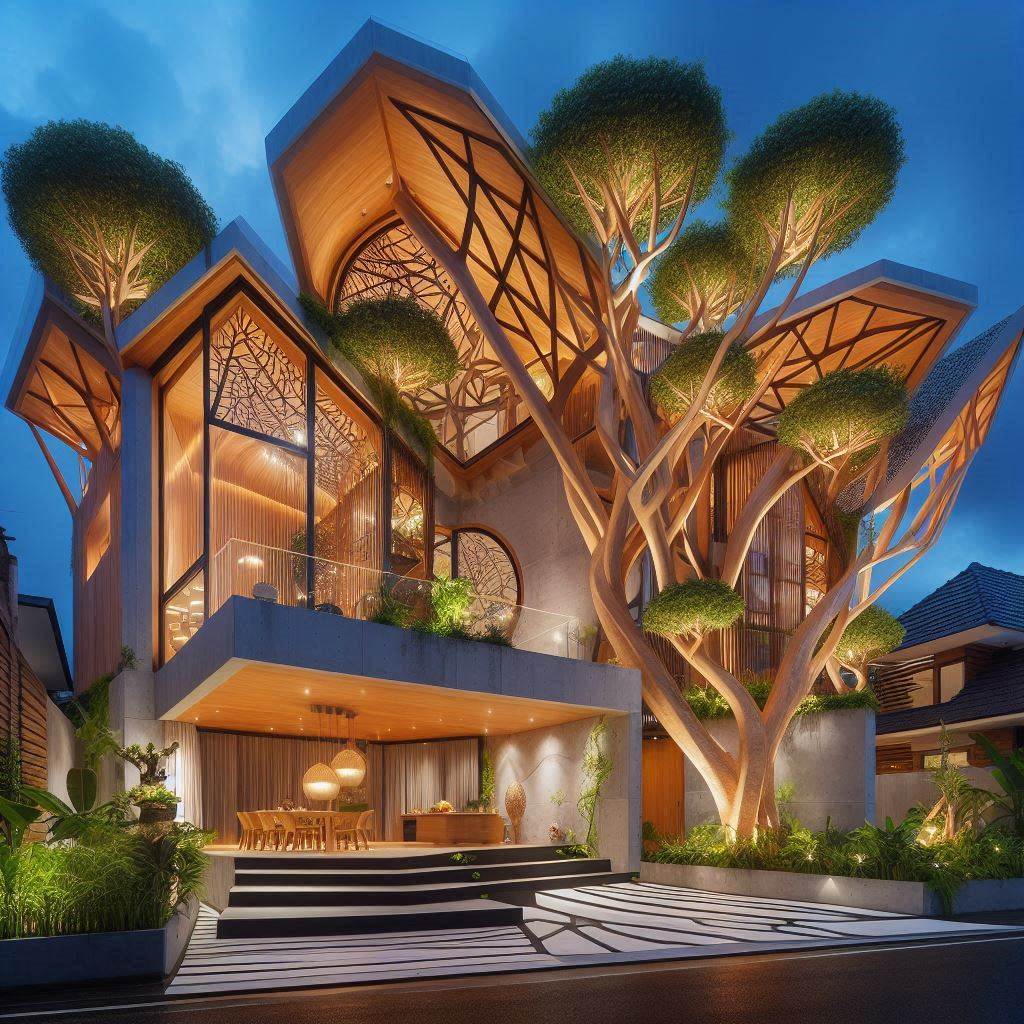
Environmental Considerations
The long-term impacts of sustainable greenhouse architecture are significant. Green rooftops improve urban biodiversity. They provide habitats for various wildlife species. They reduce heat island effects in cities.
Living walls also contribute to this goal. They filter air pollutants and improve overall air quality. These features create healthier environments for residents. Architecture Inspired by Nature’s Trees!
Sustainable designs also promote water conservation. Rainwater harvesting systems collect and reuse water for irrigation. This practice reduces reliance on municipal water sources.
Community Benefits
Greenhouses can foster community engagement. They provide spaces for education about sustainability practices. Local groups can organize workshops on organic gardening or permaculture.
These initiatives encourage residents to adopt green concepts in their homes. As people learn about sustainable methods, they may implement them in daily life. Architecture Inspired by Nature’s Trees!
Economic Impact
Investing in sustainable greenhouse architecture can lead to economic benefits. Properties with green roofs often see increased property values. Homeowners benefit from lower energy bills due to efficient designs.
Moreover, these structures can attract eco-conscious buyers or renters. Communities that prioritize sustainability may experience growth in tourism as well.
Importance of Eco-Friendly Architecture
Climate Change
Eco-friendly architecture plays a crucial role in combating climate change. Buildings account for nearly 40% of global energy consumption. Sustainable architecture reduces this impact by using renewable energy sources. Techniques like solar panels and green roofs lower energy needs and emissions. These innovations help fight the rising temperatures caused by carbon pollution.
Social Benefits
Adopting sustainable building practices brings several social benefits. Green buildings often create healthier living spaces. They use non-toxic materials that improve indoor air quality. This leads to fewer health issues among occupants. Moreover, eco-friendly designs can enhance community well-being. Parks and natural elements promote outdoor activities and social interaction. Architecture Inspired by Nature’s Trees!
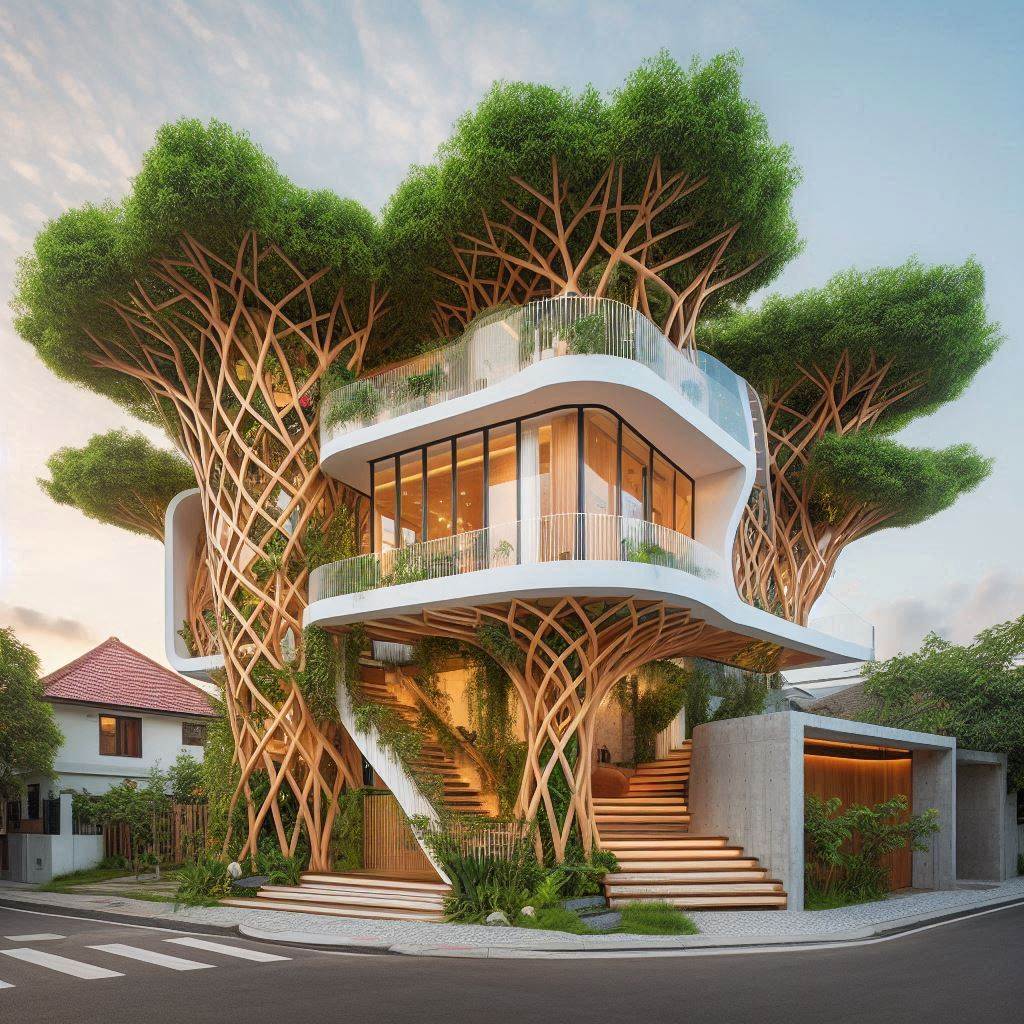
Economic Advantages
The economic advantages of green building are significant. Sustainable architecture can lower utility bills through energy efficiency. For example, homes designed with natural light reduce the need for artificial lighting. Over time, these savings add up, benefiting homeowners financially.
Green buildings can also increase property values. Many buyers prefer homes with eco-friendly features. Properties that emphasize sustainability tend to attract higher offers. This trend reflects a growing awareness of environmentalism in real estate markets. Architecture Inspired by Nature’s Trees!
Healthier Environments
Eco-friendly architecture fosters healthier environments. Buildings designed with nature in mind often include green spaces. These areas provide fresh air and recreational opportunities for residents. Access to nature is linked to improved mental health and reduced stress levels.
Sustainable materials contribute to a safer environment. They minimize exposure to harmful chemicals commonly found in traditional construction. This focus on health makes eco-friendly architecture appealing to families. Architecture Inspired by Nature’s Trees!
Future Generations
Investing in sustainable architecture ensures a better future for coming generations. By prioritizing eco-friendly designs now, society can create resilient communities. These communities will be better equipped to handle climate challenges ahead.
Incorporating trees and natural elements into architectural designs also helps biodiversity. Urban areas filled with greenery support wildlife habitats and ecosystems. This integration promotes a balanced relationship between humans and nature.
Final Remarks
Tree-inspired architecture merges nature with design, creating spaces that resonate with our environment. This approach not only enhances aesthetic appeal but also promotes sustainability. By embracing biomimicry, you can lead the way in eco-friendly living. From stunning homes to public buildings, the benefits are clear: healthier spaces and a smaller carbon footprint. Architecture Inspired by Nature’s Trees!
Now is the time to explore how these designs can transform your community and personal spaces. Consider integrating tree-like elements into your projects. You’ll not only beautify your surroundings but also contribute to a greener planet. Dive into this trend and make a positive impact today!

